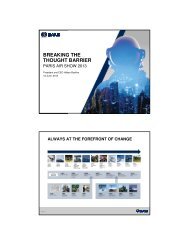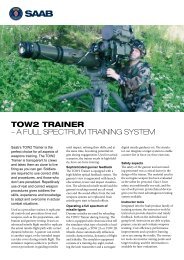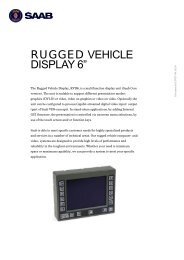ANNUAL REPORT 2009 - Saab
ANNUAL REPORT 2009 - Saab
ANNUAL REPORT 2009 - Saab
You also want an ePaper? Increase the reach of your titles
YUMPU automatically turns print PDFs into web optimized ePapers that Google loves.
ADMINISTRATION <strong>REPORT</strong> > RISKS AND RISK MANAGEMENTan estimated period of use, though not more than five toten years.If the estimated period of use is shorter than five years, the costs areamortised over the shorter period. Future business opportunities areperiodically reassessed, which can lead to impairment losses. Capitaliseddevelopment costs are shown in Note 16.Long-term customer projectsAs one of the world’s leading high-technology companies, <strong>Saab</strong>’soperations entail complex development projects on the leading edgeof technology. The competitive situation is complex, and successdepends on the ability to offer cost-effective high technology solutions,though also in some cases on participation in the customercountry’seconomy through various forms of industrial cooperation.Managing long-term customer projectsA majority of all long-term customer projects contain significantdevelopment work, which is associated with risks. Before a contractis entered into with a customer to supply a product, solution or service,a thorough analysis isalways done of the conditions and risksassociated with the delivery using an established project managementprocess. Periodic reviews are subsequently made of the projectduring its implementation stage using the same process. An importantaspect is to identify and assess risks, then take the measuresneeded to mitigate them with the help of a risk assessment method.The Group applies the percentage-of-completion method to recogniserevenue from long-term customer projects. An estimation oftotal costs is critical to revenue recognition and provisions for losscontracts as well as valuating inventories. The outcome of technicaland commercial risks may affect income.Environmental risks and liabilitiesThe most important environmental risks involve hazardous chemicals,building and plant fires, and soil contamination.Managing environmental risks and liabilitiesA number of different chemical products used in <strong>Saab</strong>’s operationsare classified as harmful to humans and the environment. The operationsin Tannefors and Malmslätt, in Linköping, and the operationsin Karlskoga are subject to the so-called Seveso law, which isdesigned to reduce risks in connection with the large-scale use ofchemicals. Against this backdrop, we have introduced strict routinesfor risk assessment, supervision and control of chemicals. Strict routinesare also applied to purchases of chemical products. Health andenvironmental information on chemical products is available in theGroup’s chemical data system, <strong>Saab</strong>Chem/SOC. <strong>Saab</strong> works activelyto assess and minimise fire risks in its operations. Since a fire in aproduction facility can cause extensive environmental damage to thelocal area, effective fire prevention is an important part of the effortsto reduce environmental risks.We analyse our operations and properties to assess <strong>Saab</strong>’s riskexposure resulting from soil contamination. When a contaminatedarea is identified, liability is determined and an overall risk assessmentis made. Information on contaminated areas is documented asit is received. In <strong>2009</strong>, an insurance solution was created to managesoil contamination cases. During the year, remediation costs ofMSEK 3 were incurred in Karlskoga.Overall risk assessments are made to determine how operationsare affected by climate change.Liquidation of leasing operations<strong>Saab</strong> decided in 1997 to discontinue the manufacture of turbopropaircraft. Like other manufacturers, <strong>Saab</strong> had a business model thatincluded lease financing in connection with aircraft sales on themarket. The risk in the portfolio consists of <strong>Saab</strong> not being able tolease out the aircraft, in which case they are not being used and <strong>Saab</strong>’sprofitability could be negatively affected.Managing risks in connection with the leasing operations<strong>Saab</strong>’s direct risk-taking in the leasing fleet has been managed primarilythrough various types of insurance. The leasing fleet is expectedto be liquidated around 2015.As of 31 December <strong>2009</strong>, <strong>Saab</strong>’s leasing portfolio consisted of 114turboprop <strong>Saab</strong> 340 and <strong>Saab</strong> 2000 aircraft. Of the fleet, 42 arefinanced through US leverage leases. Rents from these leases areinsured through the Export Credits Guarantee Board (EKN) in Sweden.71 aircraft are financed internally and recognized as assets in thebalance sheet. Rents from these leases previously were insuredthrough a number of international insurance companies. In 2008 and<strong>2009</strong> agreements were reached with these reinsurers to unwind theirinterests in return for a consideration to <strong>Saab</strong> based on the calculatedpresent value of future claims from the insurances. The considerationamounted to MUSD 78 and has been reserved on the balance sheet. Inaddition, one aircraft refer to an obligation to re-purchase the aircraft.Provisions on the balance sheet related to the leasingportfolio aredeemed as sufficient for the remaining risks.FINANCIAL RISKSIn its operations, <strong>Saab</strong> is exposed to various financial risks such asforeign currency, interest rate, refinancing, credit and commodityrisks. Management of financial risks is governed by the CorporateTreasury Policy established by the Board of Directors. Moreover,detailed directives and processes are in place for operating managementof each area. Overall responsibility for managing financial riskslies with the Corporate Treasury function. Financial risk managementis described in more detail in Note 41.saab <strong>ANNUAL</strong> <strong>REPORT</strong> <strong>2009</strong> 53


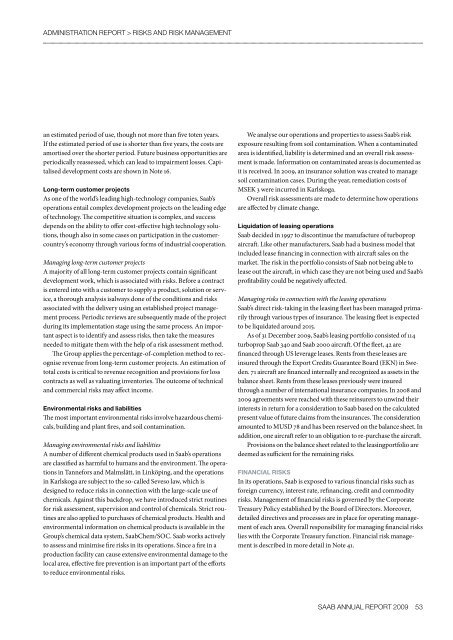

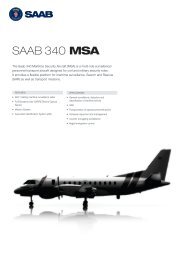
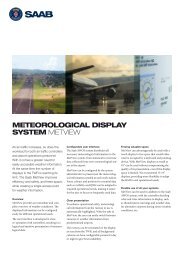
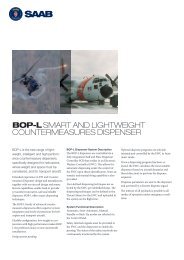

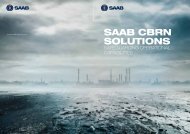
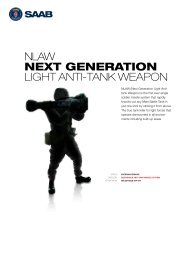
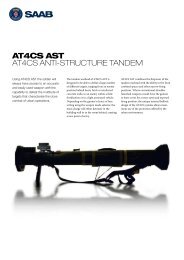


![Proposal long-term incentive programs [pdf] - Saab](https://img.yumpu.com/50411723/1/190x245/proposal-long-term-incentive-programs-pdf-saab.jpg?quality=85)
